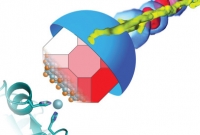
Associate Professor of Plant and Microbial Biology (and affiliate of MCB's Division of Cell and Developmental Biology) Arash Komeili, and his collaborators, which include MCB Professors Michelle Chang and James Hurley, have discovered how magnetic compasses form in bacteria, which allow them to navigate their environment.
It turns out that most of these “magnetotactic” bacteria repurpose a commonplace enzyme and use it as a scaffold on which to assemble iron atoms into tiny magnets. The new findings suggest that the scaffold protein, called MamO, may actually guide iron atoms into position in a magnetite crystal lattice.
Image: An inactivated protein, MamO (lower left), shepherds iron atoms directly to the growing magnetite crystal (red), which forms inside a membrane compartment (blue). The yellow filaments are proteins that organize the crystals into chains in the cell. The chain of magnets helps the bacteria align with Earth’s magnetic field. David Hershey image, UC Berkeley.